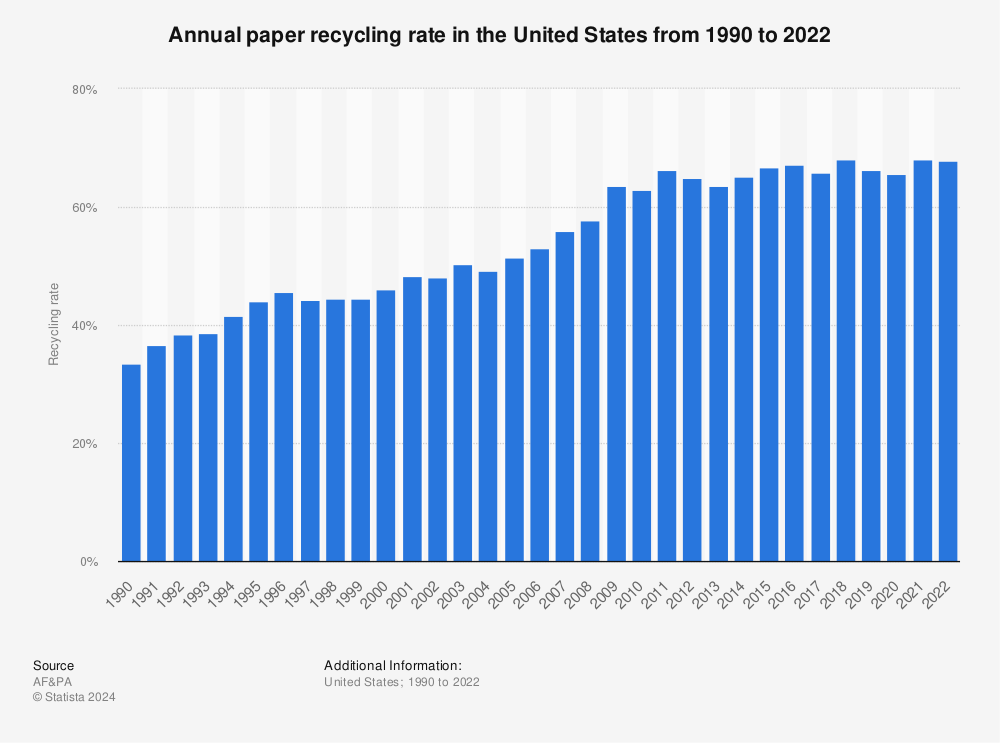
Eco-friendly printing is not only good for the environment—it’s also good for business. Today’s customers are more eco-conscious than ever and frequently seek out companies that make concerted efforts to go green and reduce their carbon footprint.
While stable the past few years, look at how the rate of paper recycling has increased in the United States over the last three decades, almost doubling to 70%:

Find more statistics at Statista
Despite the bump in recycling rates, however, pulp and paper are still the third-largest industrial polluter of air, water and soil. When left to rot, paper emits methane gas, which is 25 times more toxic than carbon dioxide.
Greener Options Abound
Fortunately, it’s now easier than ever for companies to do their part. Businesses can choose from a variety of eco-friendly materials and printing techniques that can be easily applied to dozens of items, from boxes, direct mail, business cards and flyers to posters, booklets and signage—with consistent, high-quality results.
Essentially, if you want to go green on your next printing project, there’s a way to do it!
Ready to Go Green? Here’s How:
Recycled Paper
This is a BIG category in the printing world, with dozens of options available for direct mail, brochures, flyers and other printed pieces. Some of the most popular types of recycled paper include:
- Pre-Consumer: Made from paper products that never made it to the consumer for various reasons, such as paper scraps generated from trimming at an envelope manufacturer.
- Post-Consumer: Produced from paper that was used by a consumer then recycled (think of the paper you throw in your recycling bin at home!).
- Chlorine-Free: Using chlorine-based bleaches during paper production stimulates the release of toxic materials into our water, air and soil. Chlorine-free paper uses alternative bleaching agents such as ozone, oxygen and peroxide to achieve the same results.
- FSC Certified: Paper certified by the Forest Stewardship Council is made of responsibly sourced “virgin” tree fibers instead of recycled fibers.
Keep in mind the amount of recycled material in paper can vary tremendously, from 30 percent up to 100. Due to the sheer number of options and formats available, it’s helpful to talk to an experienced “green” printer to narrow your choices.

Soy Inks
A plant-based ink made from soybeans, soy ink is more environmentally friendly than traditional, petroleum-based ink. While it’s a slower-drying ink, it’s biodegradable, easier to remove from paper (making it better for recycling!) and produces brighter, more precise color. Soy inks also do not release Volatile Organic Compounds (VOCs) into the air. Exposure to VOCs can cause a variety of health problems and contribute to the formation of ground-level ozone.
UV Inks
Ultraviolet (UV) inks are not absorbed like solvent-based inks; instead, they “sit” on top of the paper or plastic material and dry instantly via UV light. Since they dry so quickly, UV inks create sharper, more vibrant colors and images. They release very few VOCs into the air and show remarkable resistance against fading and weather.
Biodegradable Signage
This type of temporary signage is fully recyclable, compostable and water-resistant. It’s also printed with eco-friendly, carcinogen-free inks. Many biodegradable signs can last months (or more!), and disposal is easy and environmentally sound since the material breaks down naturally over time.
Recyclable Packaging & Filler:
Despite the increase in recycling rates overall, over 80 million tons of packaging material ends up in landfills each year. Many consumers are fed up with wasteful packaging and willing to pay a bit more for eco-friendly alternatives. Options abound, depending on the product, budget and volume. For your next custom box or packaging project, consider using recycled cardboard boxes or packaging made from natural materials like cornstarch, mushrooms and even seaweed! For fillers, go green with biodegradable packaging peanuts, corrugated bubble wrap or air pillows made from recycled content.
What About Cost?
Eco-friendly printing is more affordable than you might think, and many companies feel the environmental benefits more than justify the incremental cost. And as recycled printing products become more common and new options enter the marketplace, prices will continue to decrease.
Get Started Today!
Need help “greening” your next printing project? United GMG can walk you through the options available and help you determine the most eco-conscious materials and printing techniques for your needs. Contact your United GMG sales rep or call 312-427-3537 today to get started.


